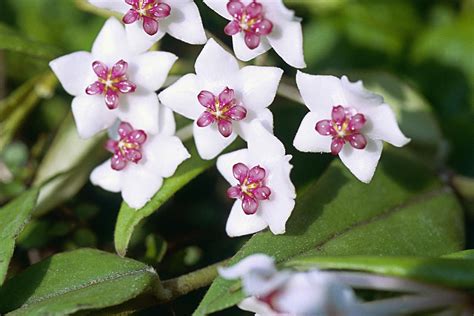A hoya is a genus of flowering plants in the milkweed family, Apocynaceae. They are native to tropical and subtropical Asia, Australia, and the Pacific Islands. Hoyas are evergreen vines with fleshy leaves and waxy flowers. They are popular houseplants because they are relatively easy to care for and can tolerate a wide range of conditions.

Characteristics of Hoyas
Hoyas are characterized by their:
- Fleshy leaves: Hoya leaves are thick and succulent, which helps them to store water. This makes them drought tolerant and ideal for growing in areas with low rainfall.
- Waxy flowers: Hoya flowers are waxy and come in a variety of colors, including white, pink, red, and yellow. They are often fragrant and bloom in clusters.
- Vining habit: Hoyas are vines and can grow up to 20 feet long. They can be trained to grow on trellises, fences, or other structures.
Types of Hoyas
There are over 200 species of hoyas, but only a few are commonly grown as houseplants. Some of the most popular types of hoyas include:
- Hoya carnosa: This is the most common type of hoya and is often called the wax plant. It has thick, oval leaves and produces clusters of white or pink flowers.
- Hoya bella: This hoya has smaller leaves than Hoya carnosa and produces clusters of pink or red flowers.
- Hoya pubicalyx: This hoya has fuzzy leaves and produces clusters of white or yellow flowers.
- Hoya kerrii: This hoya is also known as the sweetheart plant because it has heart-shaped leaves. It produces clusters of white or pink flowers.
Care for Hoyas
Hoyas are relatively easy to care for and can tolerate a wide range of conditions. However, they do have some specific needs:
- Light: Hoyas prefer bright, indirect light. They can tolerate low light conditions, but they will not bloom as much.
- Water: Hoyas should be watered when the soil is dry to the touch. Avoid overwatering, as this can lead to root rot.
- Humidity: Hoyas prefer high humidity levels. They can be grown in a humidifier or on a pebble tray filled with water.
- Fertilizer: Hoyas should be fertilized monthly during the growing season. Use a balanced fertilizer diluted to half strength.
- Repotting: Hoyas should be repotted every 2-3 years. Use a well-draining potting mix.
Benefits of Growing Hoyas
Hoyas are not only beautiful plants, but they also offer several benefits:
- Air purification: Hoyas are known to remove toxins from the air, including formaldehyde, benzene, and trichloroethylene.
- Stress relief: Studies have shown that looking at plants can reduce stress levels. Hoyas are a beautiful and easy-to-care-for plant that can help you relax and de-stress.
- Improved sleep: Hoyas can help to improve sleep quality by releasing oxygen at night.
Conclusion
Hoyas are a beautiful and easy-to-care-for plant that can add a touch of beauty to any home. They are also known to offer several health benefits, including air purification, stress relief, and improved sleep. If you are looking for a low-maintenance plant that will add a touch of beauty and relaxation to your home, then a hoya is a great choice.
Additional Information
Here are some additional resources that you may find helpful:
- American Hoya Society: www.americanhoyasociety.org
- International Hoya Association: www.internationalhoyaassociation.org
- HoyaPlants.com: www.hoyaplants.com
FAQs
Q: Are hoyas poisonous?
A: No, hoyas are not poisonous to humans or animals. However, the sap can irritate the skin and eyes of some people.
Q: How often should I water my hoya?
A: Hoyas should be watered when the soil is dry to the touch. Avoid overwatering, as this can lead to root rot.
Q: How much light do hoyas need?
A: Hoyas prefer bright, indirect light. They can tolerate low light conditions, but they will not bloom as much.
Q: What is the best way to fertilize my hoya?
A: Hoyas should be fertilized monthly during the growing season. Use a balanced fertilizer diluted to half strength.
Q: How often should I repot my hoya?
A: Hoyas should be repotted every 2-3 years. Use a well-draining potting mix.
Q: What are the most common problems with hoyas?
A: The most common problems with hoyas are overwatering, underwatering, and pests.
